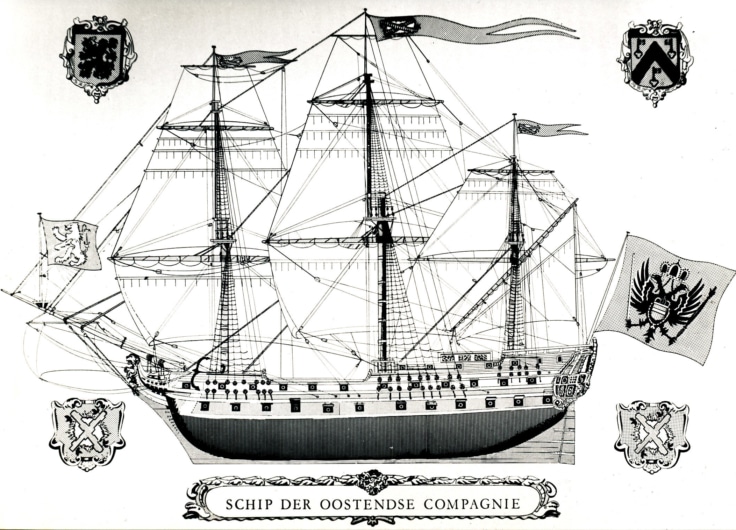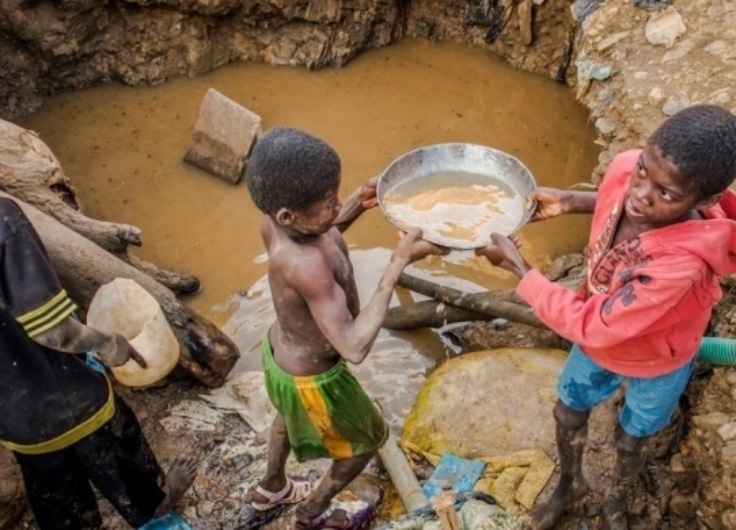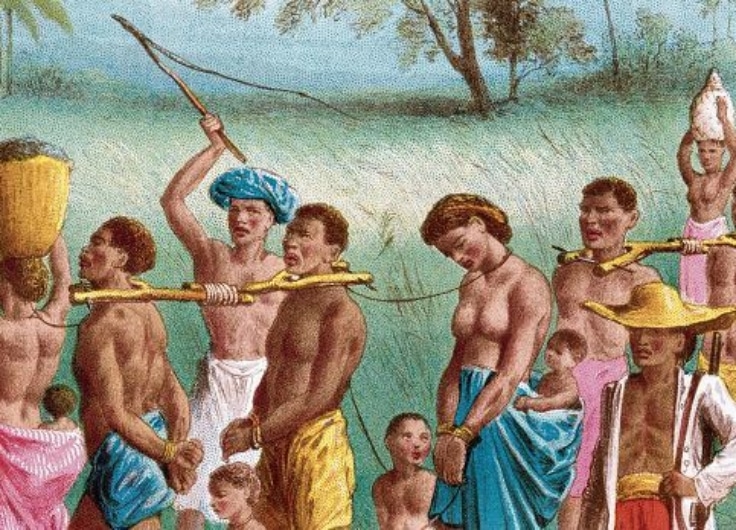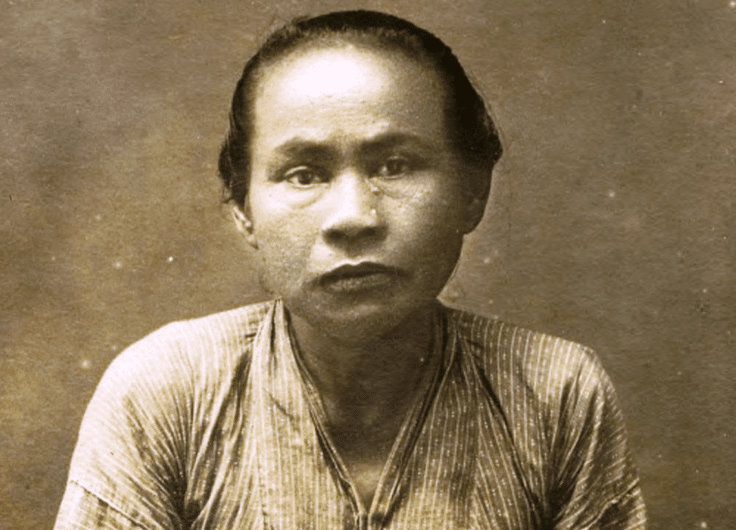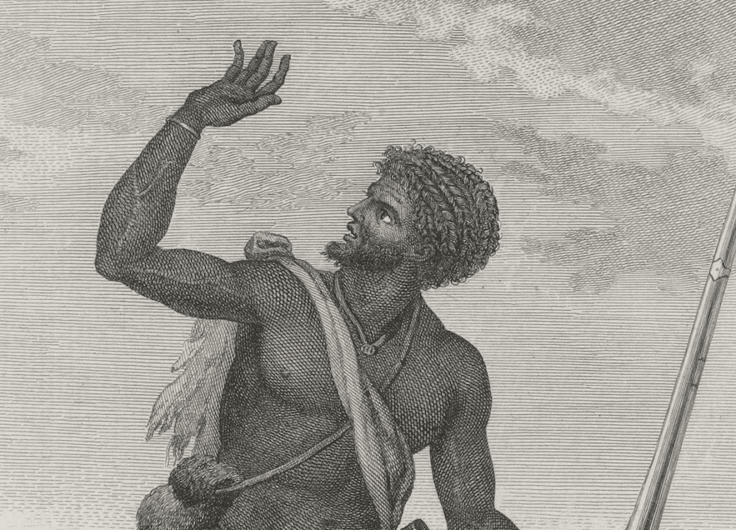Approved by the Bible. The Slave Trade of the Dutch West India Company
Founded four hundred years ago, the Dutch West India Company (WIC) waged war at sea, and colonized territories in West Africa and the Caribbean until its dissolution in 1791. The WIC not only traded in goods, but also in people. Why did the Company become involved in the transatlantic slave trade? And how many enslaved people did it trade in total?
Plans for the establishment of a West India Company had been around for some time. Willem Usselincx was the first to propose the establishment. He was a merchant who had fled to the Republic of the Seven United Provinces of the Netherlands after the Fall of Antwerp in 1585, and was particularly interested in the colonization of the Caribbean. In 1600, he sent his plans to the States General, the administrations of several cities, and other people of influence. In the years that followed, the various parties discussed the organization of the Company and worked on a patent.
 Portrait of Willem Usselinx, merchant and founder of the Dutch West India Company, 1637
Portrait of Willem Usselinx, merchant and founder of the Dutch West India Company, 1637© Rijksmuseum, Amsterdam
But the time was unfavorable. Since 1606, the Republic and Spain had been negotiating a truce with one another. Spain’s demands included that the Republic would withdraw from the Caribbean and not establish a West India Company. When the armistice was finally signed in 1609, the plans to establish the Company had to be abandoned.
After the end of the armistice in 1621, plans for the establishment of a West India Company immediately resurfaced. Usselincx was sidelined, and a new patent was prepared. On June 3 of that year, the WIC was founded. The States General granted the Company exclusive rights to shipping and trade in Africa and the Atlantic area. The patent stated: “[T]hat the shipping, trade, and commerce in the quarters of the West Indies and Africa, and others hereafter designated, shall henceforth not be carried on otherwise than by the unified power of the merchants and citizens of these countries, and that to this end a general partnership shall be established ….”
 Flag of the Dutch West India Company, according to Bowles's naval flags of the world, 1783
Flag of the Dutch West India Company, according to Bowles's naval flags of the world, 1783© Wikipedia
The organization of the WIC showed many similarities with the Dutch East India Company (VOC), founded in 1602. The administration was divided over five chambers (offices): Amsterdam, Zeeland (Middelburg), the Noorderkwartier (Hoorn), Maze (Rotterdam), and Stad en Lande (Groningen). Each chamber was governed by trustees, whose number varied per chamber and also changed several times in the history of the Company. The main shareholders of the respective chamber elected these trustees. The highest governing body of the WIC was the Nineteen Gentlemen, later the Ten Gentlemen, which met several times each year to discuss the policies of the Company.
Anyone interested could buy shares at the various WIC chambers. Not only merchants and mayors, but also people from lower professional classes invested in the Company.
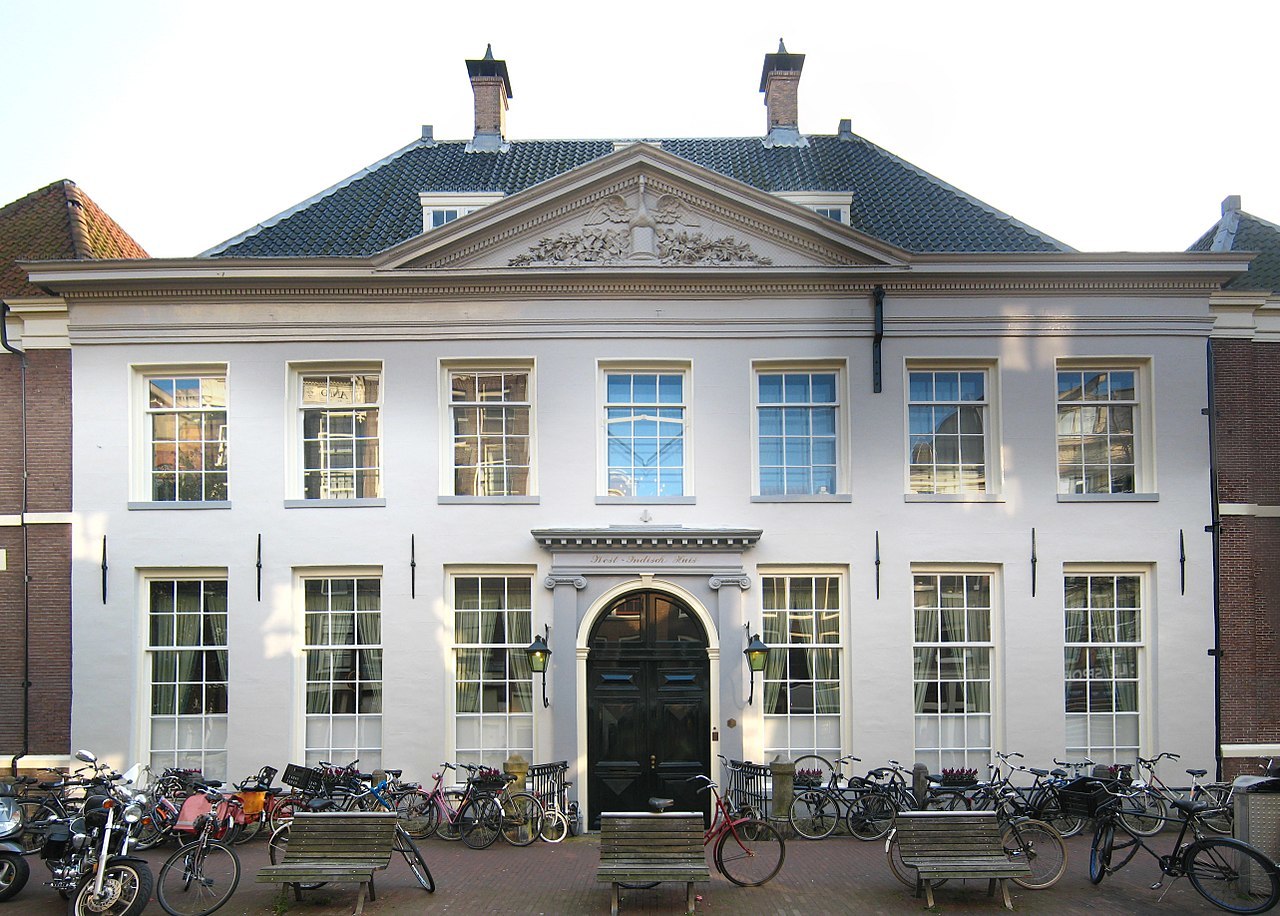 The West India House in Amsterdam, headquarters of the Dutch West India Company from 1623 to 1647
The West India House in Amsterdam, headquarters of the Dutch West India Company from 1623 to 1647© Wikiwand
Privateering and colonization
Although the agreement outlined that the Republic would withdraw from the Caribbean during the armistice with Spain, several areas had already been colonized by the Dutch. Joost van der Hooge (dates unknown) established a settlement in Essequibo (present-day Guyana) in 1616. Adriaen Block (1567-1627) sailed to the Hudson River between 1611 and 1613, which would eventually result in the colonization of New Amsterdam (New York). The WIC continued the colonization of the Caribbean.
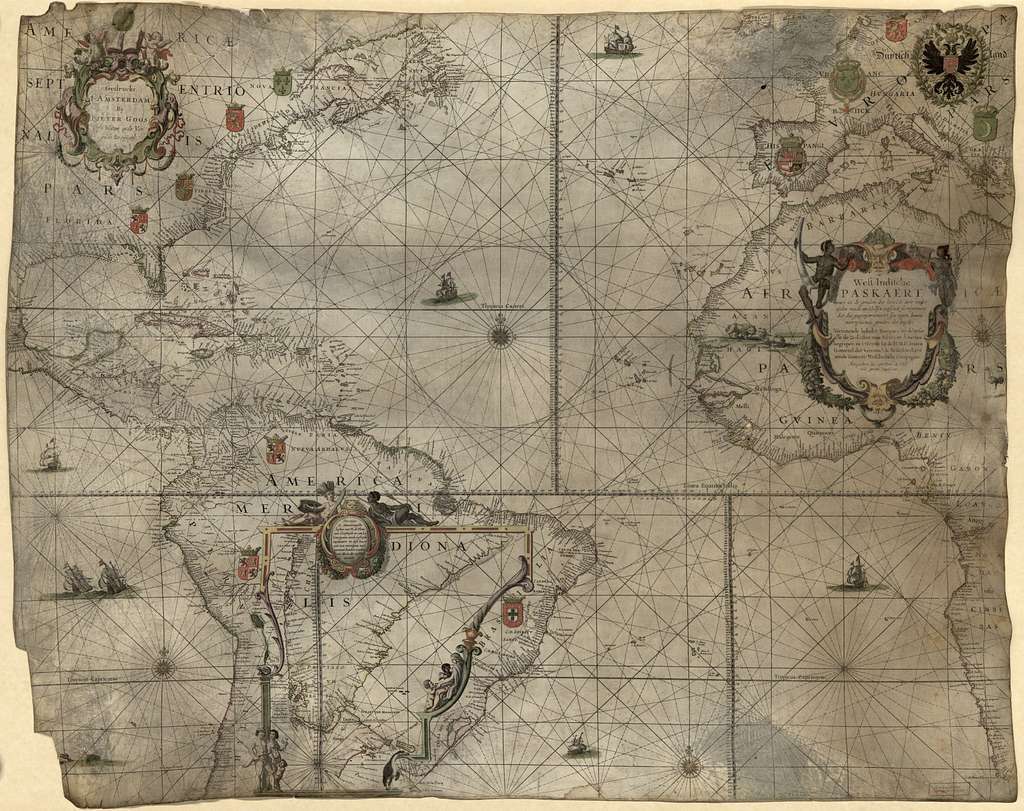 Map of the WIC (1650) showing the west coast of North America, both coasts of South America, Mediterranean Europe, and the east coast of Africa.
Map of the WIC (1650) showing the west coast of North America, both coasts of South America, Mediterranean Europe, and the east coast of Africa.© New York Public Library
Colonization in that area, however, meant a direct struggle with the Spanish and the Portuguese, who were dominantly present there. In the first years of its establishment, the Company’s main focus was therefore privateering. Ships were given permission by the States General to attack and capture enemy ships, with a so-called ‘letter of marque.’ WIC ships attacked Spanish ships to block the silver supply to Europe and, at the same time, conquered more and more colonies in the Caribbean.
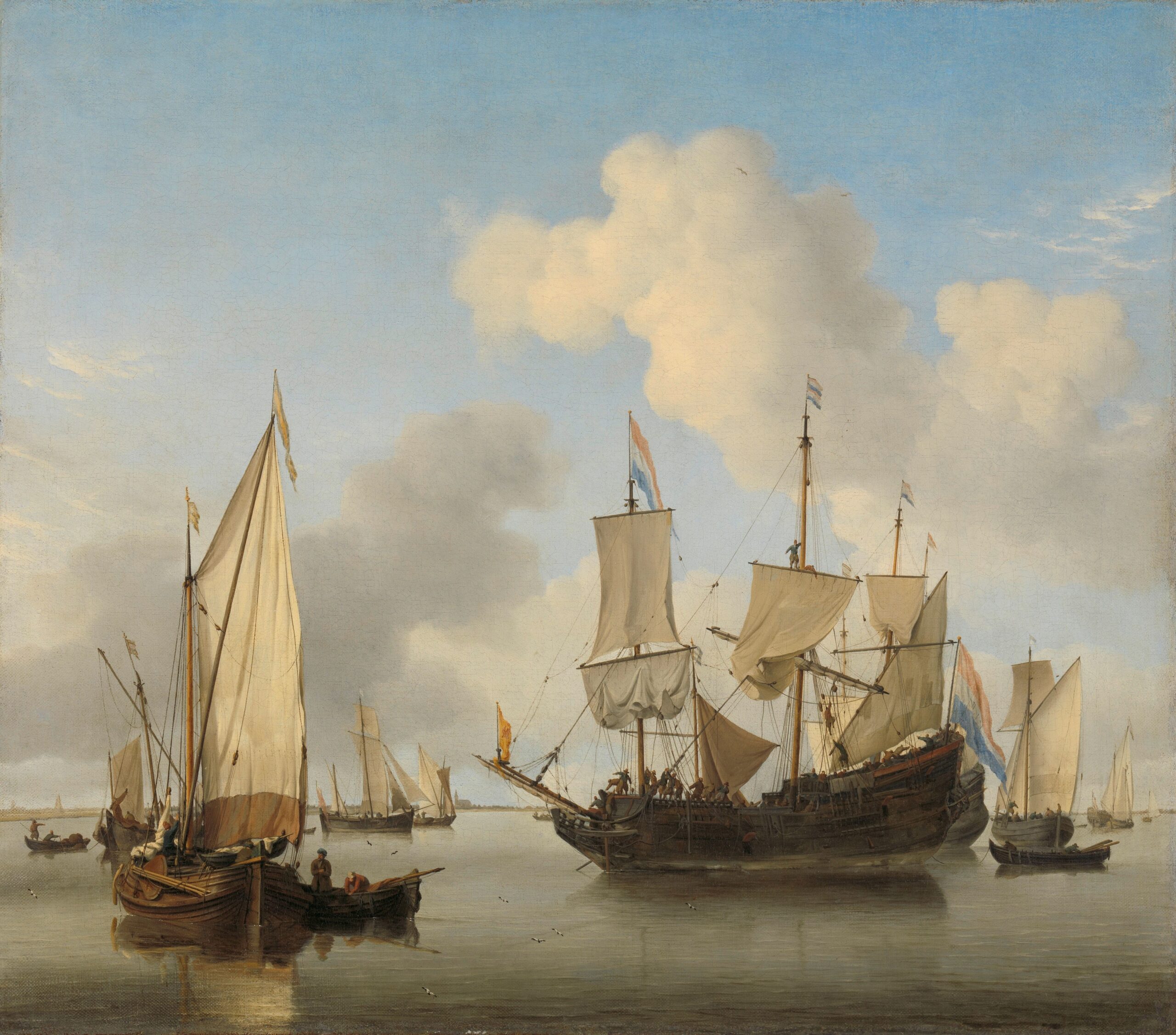 Willem van de Velde (II), Ships at Anchor on the Coast, c. 1660. The biggest ship belongs to the WIC
Willem van de Velde (II), Ships at Anchor on the Coast, c. 1660. The biggest ship belongs to the WIC© Rijksmuseum, Amsterdam
In 1628, Piet Hein (1577-1629) captured the Spanish Silver Fleet quite easily. The ships carried silver, gold, pearls, and other goods with a total value of 11.5 million guilders. It was a victory for the Republic, which was able to use the money to finance the Siege of ‘s-Hertogenbosch (1629) and thus continue to fight against Spain.
In the 1630s, more and more territories fell into Dutch hands, including Saba, the ABC islands (Aruba, Bonaire, and Curaçao), and St. Eustatius. The same thing happened to the Portuguese Brazil, after which Johan Maurits van Nassau-Siegen (1604-1679) was appointed governor-general of the colony Dutch Brazil.
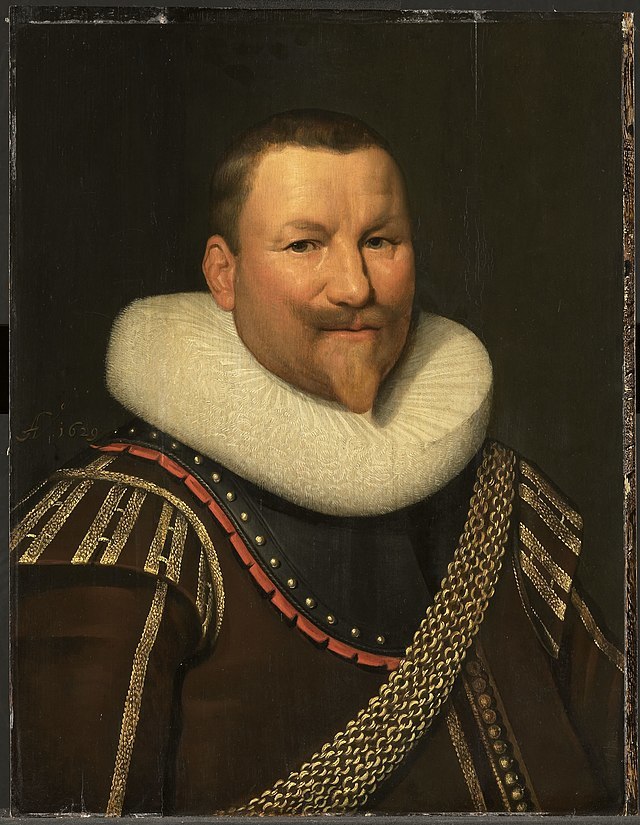 Portrait of Piet Hein, admiral of the WIC who captured the Spanish ‘Silver Fleet’ in 1628
Portrait of Piet Hein, admiral of the WIC who captured the Spanish ‘Silver Fleet’ in 1628© Rijksmuseum, Amsterdam
The sugar plantations established by the Portuguese in Brazil required slave labor. But the trade in slaves was still largely uncharted territory for the WIC. The question was not only how the WIC could supply its new possessions with slave labor, but also whether the trade in enslaved people was permitted by the Bible, a debate that had been going on for much longer in the Republic.
Approved by the Bible
Initially, the Republic was strongly opposed to the slave trade. When a ship carrying over a hundred enslaved Africans arrived in Middelburg in 1596, there was a fierce discussion about what to do with the people on board. The captain wanted to sell them in the Republic. The Middelburg town council and the States General refused. The captain could do whatever he wanted, except he wasn’t allowed to sell the enslaved people in the Republic, as slavery did not exist there. It is still unknown what happened to the enslaved people on board.
When the WIC was founded in 1621, some shareholders had already proposed to participate in the transatlantic slave trade. But after discussions with various theologians, the trustees decided that the trade in humans was not morally justified. In addition, in the early seventeenth century the WIC barely had access to West African markets, and therefore could not ship large numbers of enslaved Africans to the West.
Initially, the Republic was strongly opposed to the slave trade
Nevertheless, in 1635, the Nineteen Gentlemen decided to engage in slave trade. The main reason for this was the conquest of Brazil, which gave the WIC ownership of a large plantation colony requiring slave labor. They also found biblical texts approving of slave trade. Thus, the Dutch could convert the ‘pagan’ Africans to the ‘correct faith.’ Others believed that Africans were descended from the curse Biblical figure Cham. Whereas it was once a point of contention, people were now actually using the Bible in various ways to justify participation in transatlantic slave trade.
In 1637, the fort Elmina Castle on the West African coast (now Ghana) was seized from the Portuguese. Thereafter, more and more forts and settlements on the West African coast came into the hands of the WIC, which gave the company access to African slave markets.
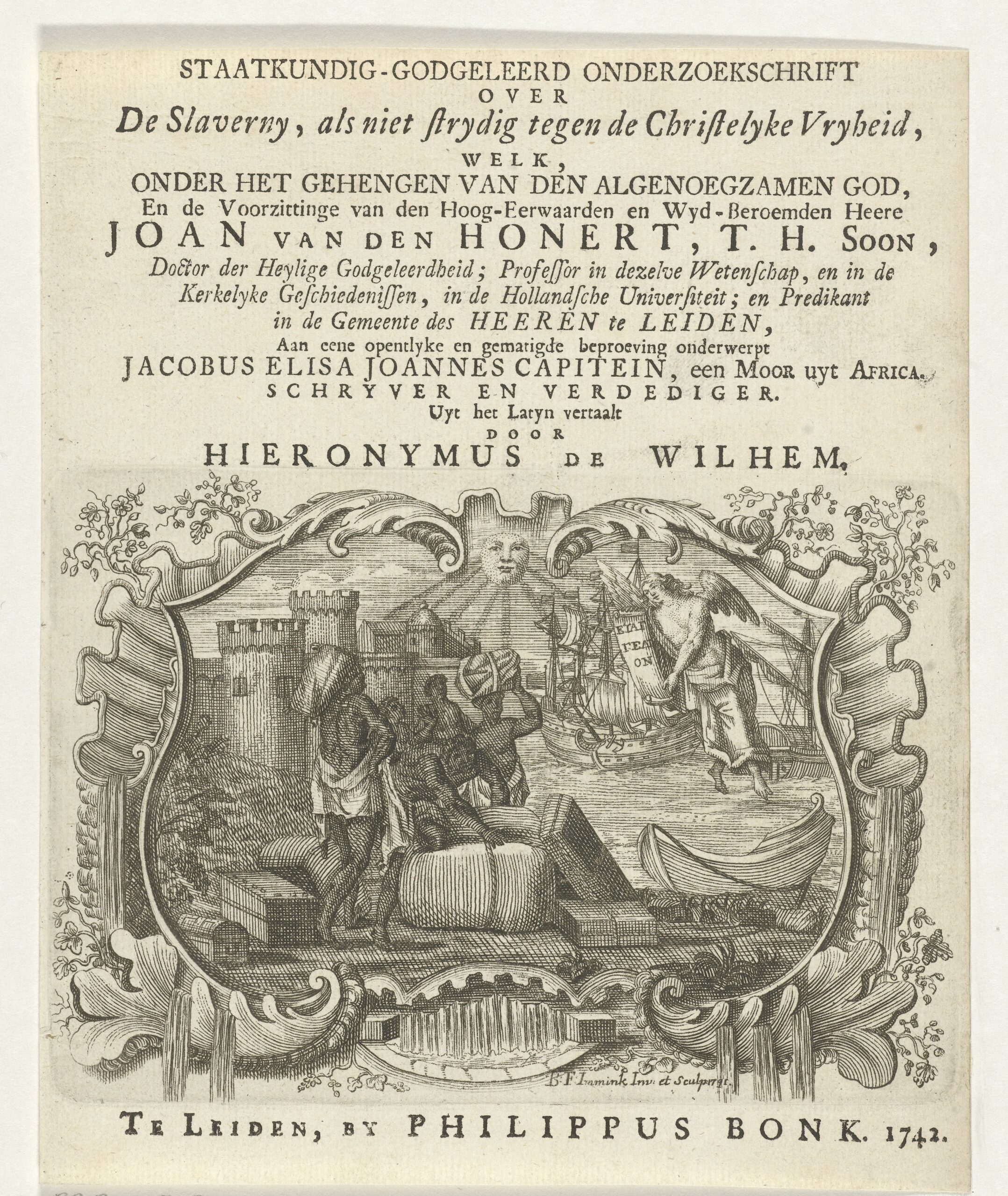 View of Fort Elmina in Ghana, engraving by B.F. Immink, 1742
View of Fort Elmina in Ghana, engraving by B.F. Immink, 1742© Rijksmuseum, Amsterdam
By the 1630s and 1640s, the WIC was the largest slave trader in the Atlantic region. Even after the loss of Dutch Brazil, the WIC continued to dominate the transatlantic slave trade, as the company was indirectly involved in the Spanish Asiento de Negros, which meant supplying the Spanish colonies with enslaved people. From this islands, enslaved Africans were shipped to the Spanish colonies and sold to private individuals. Eventually the Spanish, the Portuguese, and the English would overtake the WIC, but the Dutch involvement in the transatlantic slave trade remained.
The cruelest colony
After 1674, the WIC focused entirely on transatlantic trade, or the triangular trade. The various chambers ran ships that sailed to the coast of West Africa to exchange trade goods for gold and ivory, as well as people. The men, women, and children purchased in West Africa, had to work on plantations and in households in the Dutch colonies in the Caribbean. The slave ships then took the goods grown by slave labor on plantations, especially sugar and coffee, which were sold upon their return to the Republic.
About eighty percent of the enslaved Africans traded by the Dutch ended up in Suriname. In 1683, the Society of Suriname was founded to manage the colony from Amsterdam. The WIC, the city of Amsterdam, and the Van Aerssen van Sommelsdijck family were each one-third founders. Halfway through the eighteenth century, the colony had over five hundred plantations, on which sugar cane was mainly grown. Later, coffee and cocoa were also grown.
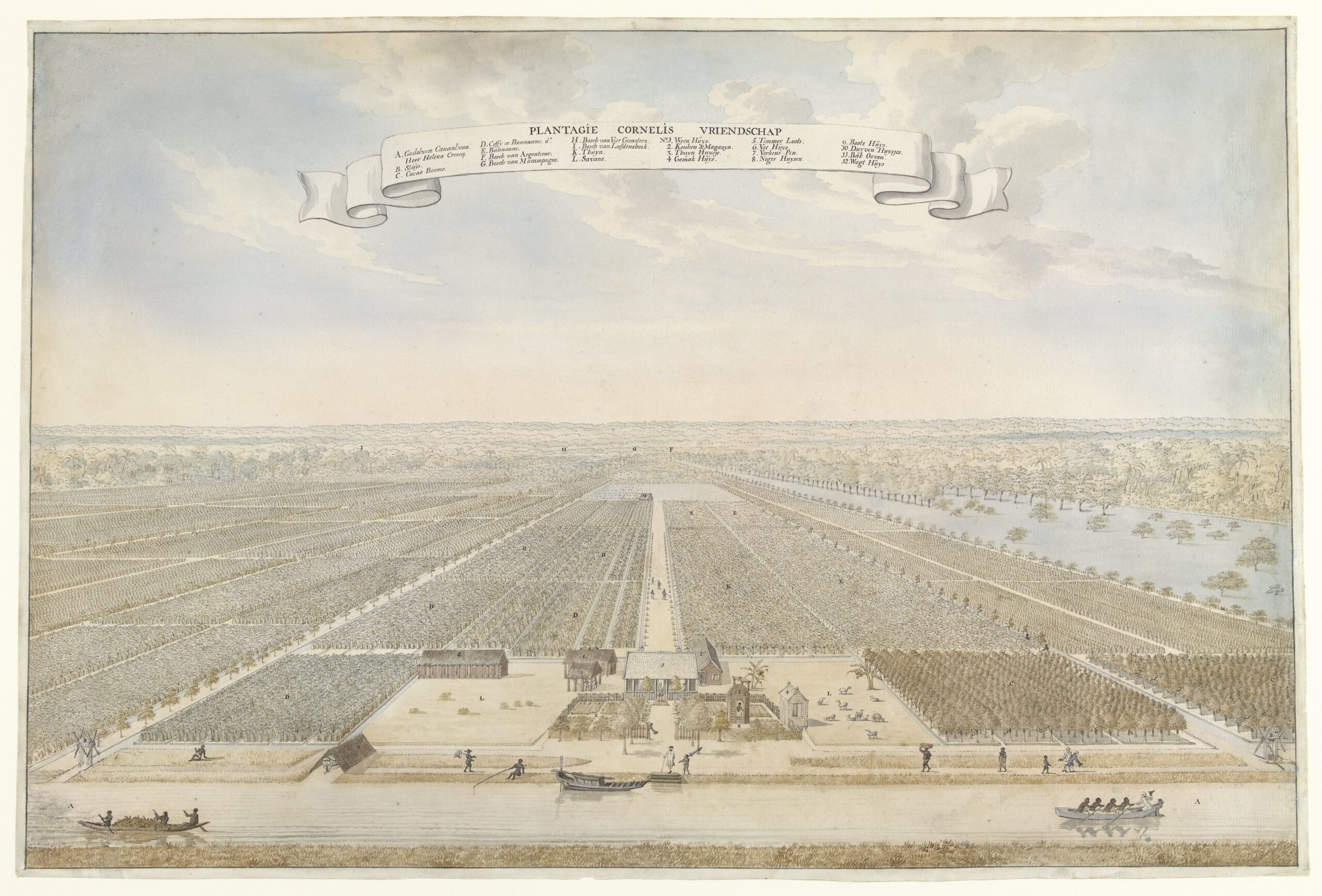 Anonymous, View of the plantation Cornelis Vriendschap in Suriname, 1700-1800
Anonymous, View of the plantation Cornelis Vriendschap in Suriname, 1700-1800© Rijksmuseum, Amsterdam
Clearing the land and harvesting and processing the sugar cane was hard work. People’s limbs regularly got stuck in the sugarcane mills, which caused enslaved people to lose limbs or even their lives. As a result, in the eighteenth-century Suriname was already known as one of the cruelest colonies in the Caribbean. There was a shortage of enslaved people, as more and more of them died than were born. Plantation owners therefore depended on the WIC, and later on private traders, to supply their plantations with enslaved Africans.
Approximately 300,000 enslaved Africans
From the fifteenth through the nineteenth century, about 12.5 million enslaved Africans were shipped to the Atlantic by European countries. Spain and Portugal were the largest slave traders, followed by England, the Netherlands, the United States, France, and Denmark. An estimated 600,000 enslaved Africans were traded by the Dutch. How large was the WIC’s share in this?
In the seventeenth and eighteenth centuries, a slave ship shipped an average of 350 enslaved people from West Africa to the colonies in the West. WIC ships regularly carried more enslaved people, averaging about six hundred. It is estimated that the WIC shipped at least 85,000 enslaved people from West Africa to the Atlantic before 1674, and at least 180,000 after 1674. Added together, this means that the WIC was responsible for about half of the total number of enslaved people shipped by the Netherlands from West Africa to the Atlantic; approximately 300,000 in total.
An estimated 600,000 enslaved Africans were traded by the Dutch
It is difficult to say how many enslaved people died aboard WIC slave ships. It is estimated that the average death rate aboard WIC ships between 1674 and 1740 was about 16.5 percent. Yet, that figure is debatable. The archives of WIC are only partially preserved. There is also a certain group that is structurally missing from the archives: babies who were born on board and also died there. They are almost entirely invisible in the archives.
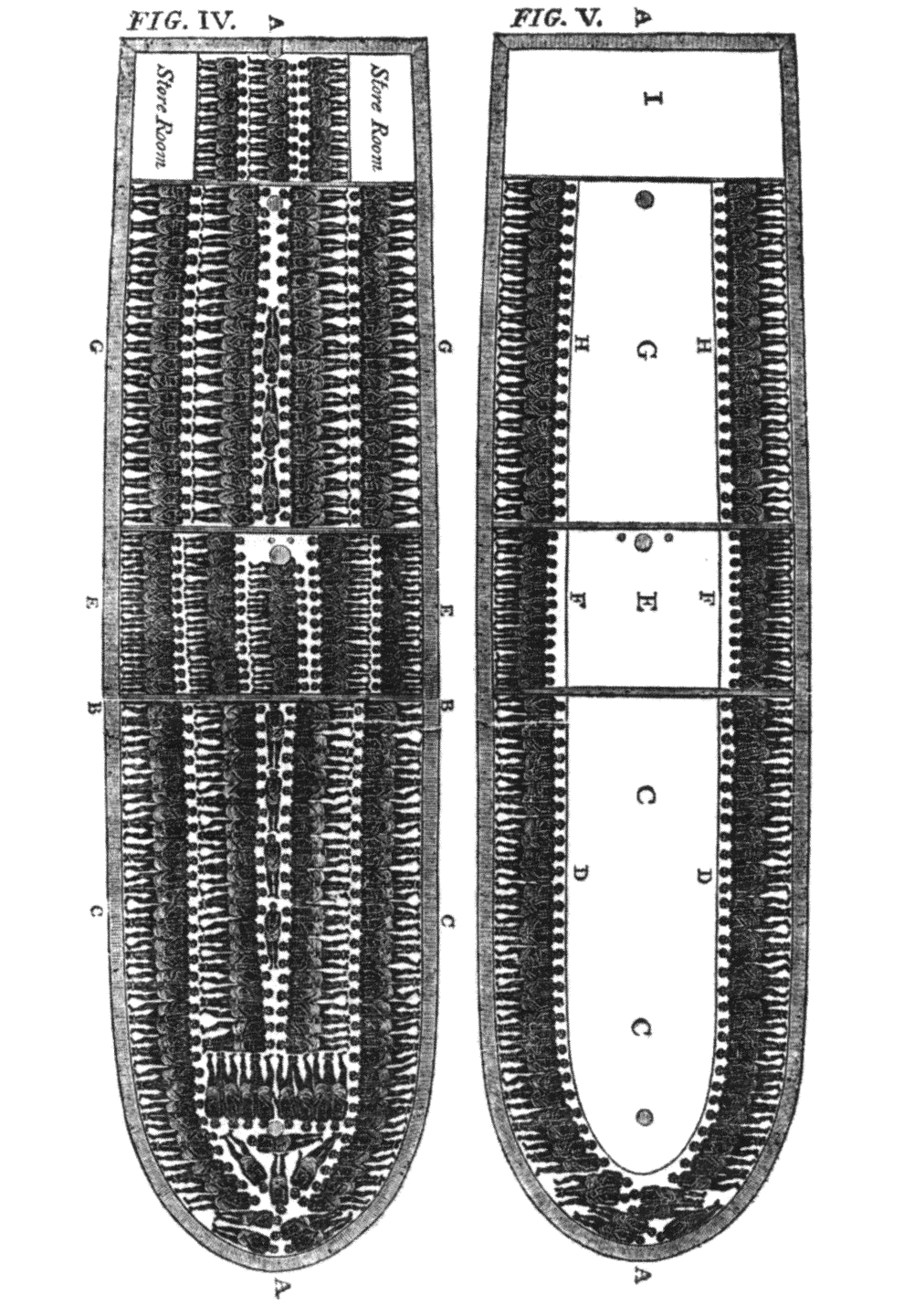 Diagram of a slave ship from the Atlantic slave trade, 1790/1791
Diagram of a slave ship from the Atlantic slave trade, 1790/1791© Wikipedia
A glaring example of the high mortality rate aboard WIC slave ships is the Leusden: This ship made ten slave voyages between 1719 and 1738, shipping a total of 6,564 enslaved Africans. Due to the wretched conditions on board, a quarter of them died on route. During the Leusden’s last voyage in 1737, the ship carried nearly seven hundred enslaved Africans that were to be sold in Suriname. Due to bad weather, captain Jochem Outjes made a major navigational error: instead of sailing up the Suriname River, he sailed up the Marowijne River, causing the ship to run into a sandbank and to start sinking. The hundreds of people on board tried to get to the upper deck to save themselves from drowning.
But the crew made the ruthless choice to batten down the hatches, which meant death for the 664 enslaved people on board. The crew themselves managed to escape the wreck. Sixteen enslaved people eventually survived the disaster, because they were allowed to stay on the upper deck for unknown reasons. Two weeks later, they were sold in Suriname.
The end
In the 1830s, the WIC lost its privileges and the transatlantic slave trade was opened up to private traders. From then on, anyone was allowed to trade in West Africa and the Dutch colonies in the Caribbean. The Middelburgsche Commercie Compagnie (“MCC,” 1720-1889) was the largest private slave trading company in the Republic. Between 1740 and 1803, the MCC shipped over 30,000 Africans to the Atlantic. But smaller companies and traders also fitted out ships for the slave trade. One example is the Rotterdam company Coopstad & Rochussen. Yet it was the people from Zeeland who dominated the slave trade. Almost eighty percent of the private slave trade was owned by Zeeland slave traders.
Almost eighty percent of the private slave trade was owned by Zeeland slave traders
Because of the open trade relationship between West Africa and the West, the WIC was barely engaged in active trade any more. The Company mainly concentrated on managing the colonies in the Atlantic area. From then on, the Company’s income consisted primarily of taxes and subscription fees. The Company was unable to recoup to large losses it had incurred at the end of the 17th century and during the War of the Spanish Succession (1701-1714).
After 1730, the Company suffered significant losses. Only during the Seven Years’ War (1754-1763) and at the beginning of the American War of Independence (1775-1783) did the WIC make large profits: when Curaçao could profit from the battle between the English and the French. As a result, the Company briefly came out of the red.
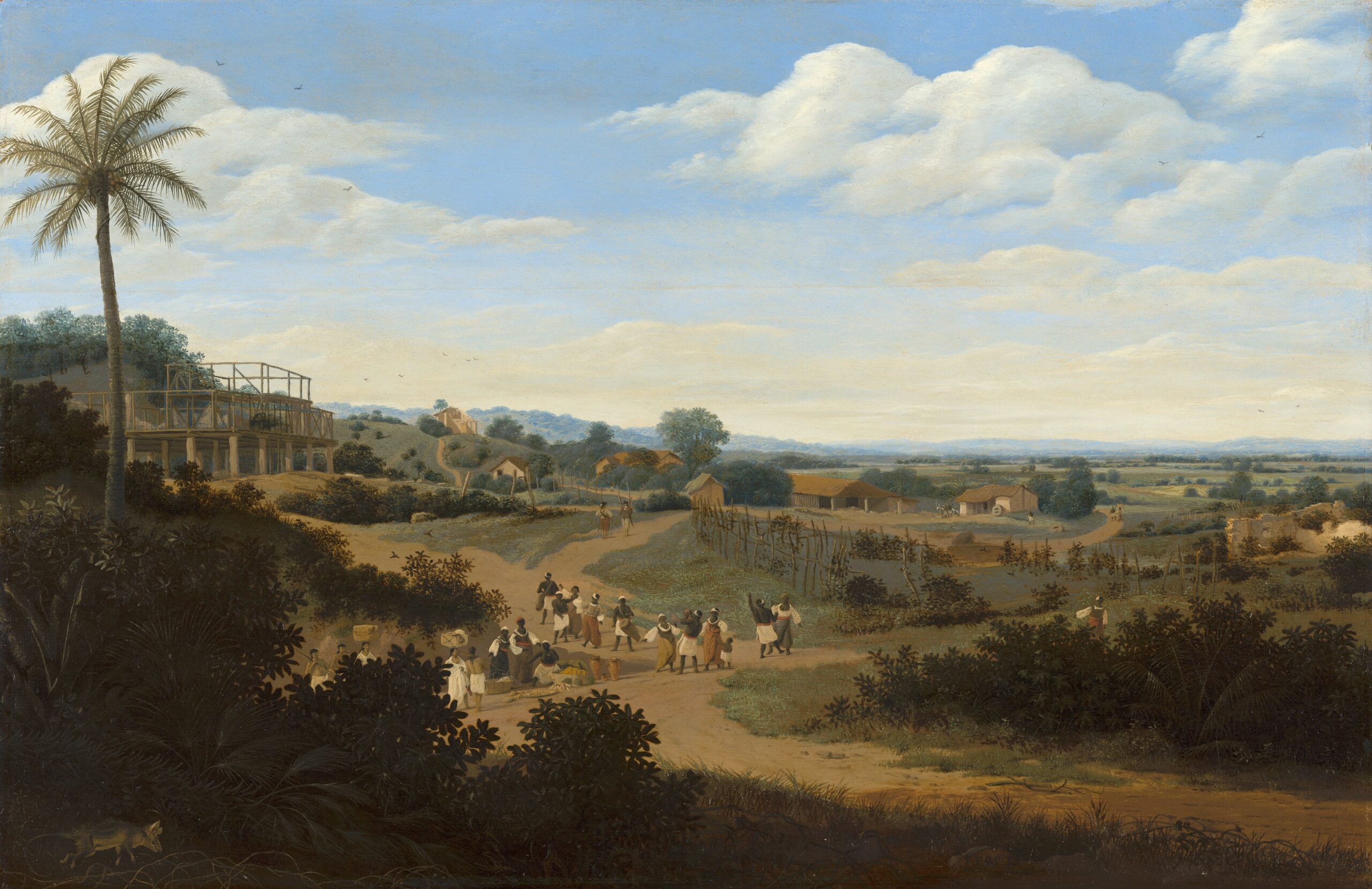 Frans Post, Brazilian landscape with a house under construction, ca. 1655-1660
Frans Post, Brazilian landscape with a house under construction, ca. 1655-1660© Mauritshuis, The Hauge
During its existence, the Nineteen/Ten Gentlemen also made several attempts to merge the WIC with the VOC, even to let the WIC be taken over completely by the VOC. But the VOC and the States General had no interest in this.
In 1674, the WIC had already gone bankrupt once, but because of the great trading importance and its colonies in the Caribbean, the Company was re-established that same year. In 1791 things were different. The States General had had to put more and more money into the Company in the previous years. Grand Pensionary Laurens Pieter van de Spiegel suggested not to extend the Company’s patent and the States General agreed. They took over the management of the colonies and the WIC was dissolved. After 171 years, the Company went down for good.
It was not until 1863 that slavery was completely abolished in the Dutch colonies
The end of the WIC, however, did not mean the end of the Dutch slave trade. The Netherlands signed an international agreement to stop slave trade in 1814, but it was not until 1863 that slavery was completely abolished in the Dutch colonies. Enslaved people still had to work on the plantations for ten years after 1863, until they were really set free. In addition, although the Dutch government paid compensation to slave owners of hundred guilders for each enslaved person, the enslaved people themselves received no compensation for the suffering inflicted on them and their ancestors.
Read more?
- Leo Balai, Slavenschip Leusden. Moord aan de monding van de Marowijnerivier, Walburg Pers, Zutphen, 2013
- Karwan Fatah-Black, Sociëteit van Suriname 1683-1795. Het bestuur van de kolonie in de achttiende eeuw, Walburg Pers, Zutphen, 2019
- Henk den Heijer, De geschiedenis van de WIC, Walburg Pers, Zutphen, 2002
- Henk den Heijer, Goud, ivoor en slaven. Scheepvaart en handel van de Tweede Westindische Compagnie op Afrika, 1674-1740, Walburg Pers, Zutphen, 1997
- Gerhard de Kok, Walcherse Ketens. De trans-Atlantische slavenhandel en de economie van Walcheren, 1755-1780, Walburg Pers, Zutphen, 2020
- Ramona Negrón, The Enslaved Children of the Dutch World. Trade, Plantations, and Households in the Eighteenth Century, (ResMA thesis) Universiteit Leiden, 2021
- Ruud Paesie, De geschiedenis van de MCC. Opkomst, bloei en ondergang, Walburg Pers, Zutphen, 2014
- Johannes Postma, The Dutch in the Atlantic Slave Trade, 1600-1815, Cambridge University Press, 1990
- Trans-Atlantic Slave Trade Database, www.slavevoyages.org


